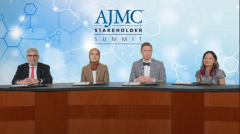
Biologics Used in Inflammatory Diseases
Maia Kayal, MD, MS, provides an overview of the biologics used in inflammatory diseases.
Episodes in this series

Ryan Haumschild, PharmD, MS, MBA: As we think more specifically about these inflammatory diseases, we know there’s a lot of medication classes, from anti-TNFs [tumor necrosis factor] to IL-17s, IL-23s, to JAK [Janus kinase] inhibitors. Dr Kayal, you’re really an expert in this space. Could you provide an overview of the biologic use in inflammatory diseases? Maybe focus on one of the upcoming biosimilars [for] adalimumab because I know we’re all awaiting that as well.
Maia Kayal, MD, MS: That’s a great question, and I’m so excited because I think now more than ever, we have a lot of great therapeutic options that we didn’t even have a couple of years ago. It’s a great time to practice in this field because we do have some great options.
As you said, we have the anti-TNF agents. These include infliximab, adalimumab, and certolizumab. We have the anti–[IL-]12/23 agent, which is ustekinumab. More recently, we’ve had the approval of the anti–IL-23 agent, which is risankizumab. We have anti-integrin therapies in inflammatory bowel disease specifically, which include vedolizumab, and it’s something that we use quite frequently for our patients with colitis and [Crohn] disease. In the last couple of years, we’ve seen the rise of small molecules like JAK inhibitors, starting with tofacitinib, which is a pan-selective JAK inhibitor, and most recently, upadacitinib, which is a JAK-1 selective agent.
It's interesting because I get the question asked a lot: Which drug for which patient at which time? The answer is there’s no one-size-fits-all. Choosing the therapy is really dependent on the patient and their risk factors, but even more importantly, we think a lot about…disease severity and…disease acuity and essentially how sick are they right now and what is the potential for them to get sicker over the long term? We think about their present illness, and then we think about their risk of progression [vs] their chronic illness essentially. Using those tidbits, you start to develop a therapeutic plan for your patient.
What’s really interesting and exciting is that, as you mentioned,…just this year alone we’ve seen the approval of multiple adalimumab biosimilars, which is really exciting because what we hope these biosimilars will…make it easier for us to treat our patients and get more drugs into patient hands in a more efficient and cost-effective way.
Ryan Haumschild, PharmD, MS, MBA: You did a great job talking about the continuum of care because we’re not just looking at these disease states in a one-time treatment or if it’s a one-time cycle. A lot of times, we’re looking at control over that time period, and patients through their progression of disease may go through different classes that you really outlined.
Transcript edited for clarity.
This activity is supported by an educational grant from Boehringer Ingelheim.
Newsletter
Stay ahead of policy, cost, and value—subscribe to AJMC for expert insights at the intersection of clinical care and health economics.








































